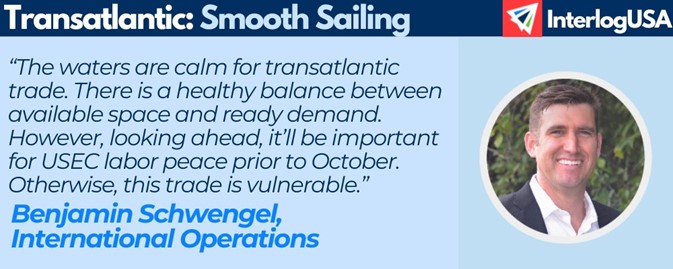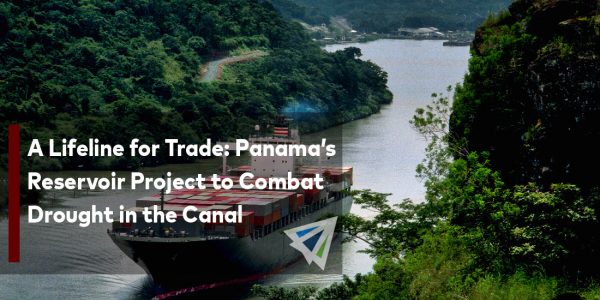Competitive Edge
August 7th, 2024
Stay Current with InterlogUSA
Latest Industry Happenings and Market Updates:
Across International Shipping: News and Developments
Hurricane Debby: Hurricane Debby breached Florida’s Gulf Coast on Monday morning, dumping heavy rain and subsequent flooding. Marked a Category 1 when it made landfall, the storm system has since made its way north, imposing similar conditions onto states in the U.S. Southeast. The following are updates from port authorities whose facilities and operations have been impacted by the storm:
- South Carolina Ports: The port authority resumed operations Wednesday under reduced gate hours at its Charleston and Dillion ports. The inland Port of Greer will resume regular hours.
- Georgia Ports: The port authority reopened the Port of Savannah’s terminals Wednesday, while cargo handling since resumed the prior day, Tuesday.
- Port Tampa Bay: Officials at the Port of Tampa Bay resumed vessel operations and reopened shipping channels Monday.
Labor: In a notice posted Aug. 3, the International Longshoremen’s Association (ILA) announced its leaders will discuss contract demands and strike strategies (if necessary) at meetings scheduled for Sep. 4-5. Since June, negotiations on a labor contract covering East and Gulf coast ports have stalled when ILA, representing unionized dockworkers, suspended talks with the United States Maritime Alliance (USMX), representing ocean carriers and terminal operators.
According to ocean carrier sources who told the Journal of Commerce, ILA is seeking nearly an 80 percent wage increase over the six-year period that the new contract will cover. For context, unionized dockworkers at West Coast ports came to terms with a 32 percent wage increase in their respective contract which was ratified last summer.
ILA has vowed its union rank-and-file will strike should an agreement not be reached before Sep. 30, when the existing contract will expire. Such a labor action would shut down East and Gulf coasts ports.
IMPORT: Asia to North America (Transpacific Eastbound)
Rates: Rates to all U.S. coasts remain extraordinarily high when compared to the historical average at this time.
Space: Space is tight on most services. In some cases, carriers have not offered the entirety of space previously awarded within their contracts with shippers and NVOs.
Capacity: Carriers have introduced more vessels into the trade, injecting more capacity to accommodate rising demand.
Routing: Amid labor uncertainty, U.S. West Coast ports are receiving an increase in cargo diversions that would otherwise be routed to the East and Gulf destinations.
TIPS:
- Hold your logistics partners accountable for frequent updates regarding current market conditions.
- Strongly consider booking shipments as soon as possible to avoid election uncertainty over trade tariffs as well as a potential dockworker strike in October (if no agreement is reached).
IMPORT: Europe to North America (Transatlantic Westbound)

Looking for transatlantic shipping solutions? Contact us today!
Rates: After several weeks of no change, rates have decreased since the start of August. However, ocean carriers have announced peak season surcharges (PSSs) for Sep. 1 in an effort to curb a declining trend.
Space: Space is open.
Capacity: There has been enough demand as well as reallocation of ships away from the transatlantic to utilize what previously has been an oversaturated supply of available vessels.
TIPS:
- Book at least two weeks prior to the ready date.
- Stay in communication with your logistics providers on anticipated surcharges for this trade lane in September.
- Keep a pulse of ongoing labor tensions between East and Gulf coasts dockworkers and maritime employers. If feasible within your timeline, place inbound bookings in August and early September to avoid disruptions if there is a dockworker strike in the fall.
EXPORT: North America to Asia
Rates: Outbound rates from the West Coast have risen slightly after a freefall earlier this summer. Meanwhile, rates from the East Coast have decreased slightly. Conditions at West Coast ports are comparatively more volatile than conditions at East Coast ones.
Capacity: As seen during the pandemic, export service is vulnerable in periods when carriers set their focus on a more favorable import market, as prioritizing inbound business is more profitable. As peak import season holds steady, exporters should be cautious of how this can impact their cargo.
TIPS:
- Insufficient communication with sailing schedules can lead to higher detention and demurrage fees as well as higher trucking and storage costs. Ensure your logistics partners are not keeping you and your cargo in the dark.
Freight News
U.S. Postpones Tariff Increases on Certain Chinese Imports
Europe's Top Ports Report a Boost in Freight Volumes in First Half of This Year
Last week, the U.S. Trade Representative (USTR) announced a two-week delay in implementing tariff increases on a variety of Chinese imports, including a 25% duty on Chinese made ship-to-shore cranes.
These tariffs were originally scheduled to begin last Thursday but are now under additional review, with a final decision expected in mid-August. The USTR is considering over 1,000 public comments received during the consultation period. The final determination, per USTR, will be made in August 2024.
While some of these tariffs are expected to take effect this year, not all of these tariffs will as some will be phased in through the next few years.
In the first half of 2024, two of Europe’s largest ports have seen an increase in freight volumes, with a recovery starting in the first quarter and continuing into the second as an early peak season boosted container throughput.
The Port of Rotterdam saw a 2.2% rise, handling 6.8 million TEUs, while the Port of Antwerp-Bruges managed 6.6 million TEUs, up 4.1% from the previous year, the JOC reports. The continuation of this trend in the second half of 2024 remains uncertain and will depend on the broader recovery of European industry, the Rotterdam Port Authority CEO said on the matter.
Which Container Port is the Busiest in all of Asia?
Answer: C – Port of Shanghai
Johnny Cargo sure knows a lot! Other than fun facts, Johnny also can provide insight into InterlogUSA’s many service and pricing options. He is always available for a quick conversation.
CLICK HERE to chat with Johnny Cargo.

Webinar: Market Updates, Current Events
In our July webinar our team discussed:
— transpacific (west coast) and transatlantic (east coast) market conditions and updates
— any updates regarding the Panama Canal/Suez Canal?
Plus, recent current events in the industry:
— U.S. East/Gulf Coast Labor Negotiations
— Rough Weather in South Africa Impacts Vessels
— Canada Rail Union TCRC and CN/CPKC Bargaining Update
Sign up for our
industry answers
Our team works to provide valuable, unique, and relevant content to assist you in finding solutions. Sign up now.

